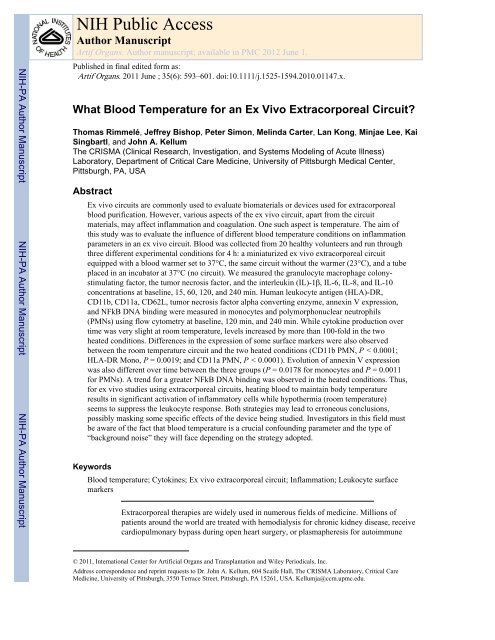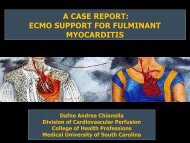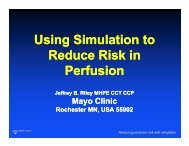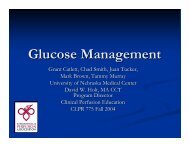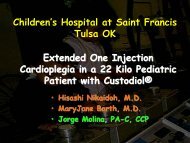Read the Full Text (PDF) - Perfusion.com
Read the Full Text (PDF) - Perfusion.com
Read the Full Text (PDF) - Perfusion.com
Create successful ePaper yourself
Turn your PDF publications into a flip-book with our unique Google optimized e-Paper software.
NIH Public Access<br />
Author Manuscript<br />
Artif Organs. Author manuscript; available in PMC 2012 June 1.<br />
NIH-PA Author Manuscript NIH-PA Author Manuscript NIH-PA Author Manuscript<br />
Published in final edited form as:<br />
Artif Organs. 2011 June ; 35(6): 593–601. doi:10.1111/j.1525-1594.2010.01147.x.<br />
What Blood Temperature for an Ex Vivo Extracorporeal Circuit?<br />
Thomas Rimmelé, Jeffrey Bishop, Peter Simon, Melinda Carter, Lan Kong, Minjae Lee, Kai<br />
Singbartl, and John A. Kellum<br />
The CRISMA (Clinical Research, Investigation, and Systems Modeling of Acute Illness)<br />
Laboratory, Department of Critical Care Medicine, University of Pittsburgh Medical Center,<br />
Pittsburgh, PA, USA<br />
Abstract<br />
Ex vivo circuits are <strong>com</strong>monly used to evaluate biomaterials or devices used for extracorporeal<br />
blood purification. However, various aspects of <strong>the</strong> ex vivo circuit, apart from <strong>the</strong> circuit<br />
materials, may affect inflammation and coagulation. One such aspect is temperature. The aim of<br />
this study was to evaluate <strong>the</strong> influence of different blood temperature conditions on inflammation<br />
parameters in an ex vivo circuit. Blood was collected from 20 healthy volunteers and run through<br />
three different experimental conditions for 4 h: a miniaturized ex vivo extracorporeal circuit<br />
equipped with a blood warmer set to 37°C, <strong>the</strong> same circuit without <strong>the</strong> warmer (23°C), and a tube<br />
placed in an incubator at 37°C (no circuit). We measured <strong>the</strong> granulocyte macrophage colonystimulating<br />
factor, <strong>the</strong> tumor necrosis factor, and <strong>the</strong> interleukin (IL)-1β, IL-6, IL-8, and IL-10<br />
concentrations at baseline, 15, 60, 120, and 240 min. Human leukocyte antigen (HLA)-DR,<br />
CD11b, CD11a, CD62L, tumor necrosis factor alpha converting enzyme, annexin V expression,<br />
and NFkB DNA binding were measured in monocytes and polymorphonuclear neutrophils<br />
(PMNs) using flow cytometry at baseline, 120 min, and 240 min. While cytokine production over<br />
time was very slight at room temperature, levels increased by more than 100-fold in <strong>the</strong> two<br />
heated conditions. Differences in <strong>the</strong> expression of some surface markers were also observed<br />
between <strong>the</strong> room temperature circuit and <strong>the</strong> two heated conditions (CD11b PMN, P < 0.0001;<br />
HLA-DR Mono, P = 0.0019; and CD11a PMN, P < 0.0001). Evolution of annexin V expression<br />
was also different over time between <strong>the</strong> three groups (P = 0.0178 for monocytes and P = 0.0011<br />
for PMNs). A trend for a greater NFkB DNA binding was observed in <strong>the</strong> heated conditions. Thus,<br />
for ex vivo studies using extracorporeal circuits, heating blood to maintain body temperature<br />
results in significant activation of inflammatory cells while hypo<strong>the</strong>rmia (room temperature)<br />
seems to suppress <strong>the</strong> leukocyte response. Both strategies may lead to erroneous conclusions,<br />
possibly masking some specific effects of <strong>the</strong> device being studied. Investigators in this field must<br />
be aware of <strong>the</strong> fact that blood temperature is a crucial confounding parameter and <strong>the</strong> type of<br />
“background noise” <strong>the</strong>y will face depending on <strong>the</strong> strategy adopted.<br />
Keywords<br />
Blood temperature; Cytokines; Ex vivo extracorporeal circuit; Inflammation; Leukocyte surface<br />
markers<br />
Extracorporeal <strong>the</strong>rapies are widely used in numerous fields of medicine. Millions of<br />
patients around <strong>the</strong> world are treated with hemodialysis for chronic kidney disease, receive<br />
cardiopulmonary bypass during open heart surgery, or plasmapheresis for autoimmune<br />
© 2011, International Center for Artificial Organs and Transplantation and Wiley Periodicals, Inc.<br />
Address correspondence and reprint requests to Dr. John A. Kellum, 604 Scaife Hall, The CRISMA Laboratory, Critical Care<br />
Medicine, University of Pittsburgh, 3550 Terrace Street, Pittsburgh, PA 15261, USA. Kellumja@ccm.upmc.edu.
Rimmelé et al. Page 2<br />
NIH-PA Author Manuscript NIH-PA Author Manuscript NIH-PA Author Manuscript<br />
disease (1–3). In critical care, 5% of patients will undergo renal replacement <strong>the</strong>rapy for<br />
acute kidney injury during <strong>the</strong>ir stay in <strong>the</strong> intensive care unit, and besides renal support,<br />
some of <strong>the</strong>se extracorporeal <strong>the</strong>rapies (high volume hemofiltration, super high-flux<br />
hemofiltration, hemoperfusion, coupled plasma filtration adsorption) are also proposed as a<br />
blood purification treatment for septic shock (4–6). Because of blood exposure to foreign<br />
materials, <strong>the</strong> extracorporeal circuit by itself is responsible for inflammation activation (7).<br />
Despite recent improvements in circuit bio<strong>com</strong>patibility, this additional production of<br />
locally formed inflammatory mediators is still considered a major adverse effect (8).<br />
For research purposes, ex vivo circuits are <strong>com</strong>monly employed because <strong>the</strong>y allow for<br />
evaluation of filters, dialyzers, sorbent cartridges, or o<strong>the</strong>r adsorption devices without any<br />
exposure to a patient or an animal, and <strong>the</strong>y can be miniaturized, thus permitting rapid<br />
screening of materials (9–13). Blood is usually placed in a reservoir and <strong>the</strong>n circulates<br />
through a closed loop with multiple passes through <strong>the</strong> device being studied. Circuit settings<br />
are not standardized and experimental conditions vary from one study to ano<strong>the</strong>r (9–13).<br />
These ex vivo extracorporeal circuits are also under <strong>the</strong> influence of <strong>the</strong> inflammatory<br />
activation due to special environmental conditions such as artificial tubing, temperature,<br />
blood movement, and blood–air interface. However, in order to evaluate blood purification<br />
devices using ex vivo circuits, it is important to establish conditions that have <strong>the</strong> least<br />
inflammatory activation possible because this activation may interfere with or overshadow<br />
<strong>the</strong> effects of <strong>the</strong> device itself.<br />
One such parameter that is known to have a significant impact on inflammatory cell<br />
activation is temperature. However, in ex vivo circuit experiments, it is unclear if work<br />
should be conducted at body temperature (37°C) or some o<strong>the</strong>r temperature (e.g., room<br />
temperature). One could argue that maintaining blood temperature at 37°C with a warmer<br />
could be physiological, but if maintaining body temperature is itself proinflammatory, <strong>the</strong>n<br />
this effect will confound any attempt to evaluate artificial material. In addition, hypo<strong>the</strong>rmia<br />
(room temperature) is known to have anti-inflammatory effects by inhibiting leukocyte<br />
response following several tissue insults such as ischemic brain or liver injury (14–16).<br />
Therefore, <strong>the</strong> aim of this study was to evaluate <strong>the</strong> influence of different blood temperature<br />
conditions on cytokine production and leukocyte surface markers expression in a<br />
miniaturized extracorporeal ex vivo circuit.<br />
MATERIALS AND METHODS<br />
Study population<br />
Ex vivo circuit<br />
The study was approved by <strong>the</strong> University of Pitts-burgh Institutional Review Board. After<br />
consent was obtained, 20 healthy volunteers donated blood for <strong>the</strong> purpose of <strong>the</strong>se ex vivo<br />
experiments. Healthy volunteers were defined as being >18 years old and not pregnant,<br />
weighing at least 50 kg, having no history of anemia or hemophilia, and having no history of<br />
chronic medical illness or acute infection during <strong>the</strong> previous 2 weeks.<br />
Blood was collected from healthy volunteers into standard vacuum-evacuated blood<br />
collection tubes containing sodium heparin. Venipuncture was performed in a dedicated<br />
room by trained personnel. The experiment consisted of running <strong>the</strong> blood through three<br />
different conditions over a period of 4 h: (i) a miniaturized ex vivo extracorporeal circuit<br />
equipped with a blood warmer set to 37°C; (ii) <strong>the</strong> same circuit without <strong>the</strong> warmer (blood<br />
kept at room temperature ~23°C); and (iii) blood samples placed into a rocking incubator at<br />
37°C (no circuit). These three experimental conditions are represented in Fig. 1.<br />
Artif Organs. Author manuscript; available in PMC 2012 June 1.
Rimmelé et al. Page 3<br />
NIH-PA Author Manuscript NIH-PA Author Manuscript NIH-PA Author Manuscript<br />
Components of <strong>the</strong> extracorporeal circuit were polyethylene tubing (Intramedic, Becton<br />
Dickinson and Company, Franklin Lakes, NJ, USA), a 15-mL conical bottom tube to serve<br />
as <strong>the</strong> 10-mL blood reservoir (Becton Dickinson), silicone tubing and a mini-pump (Control<br />
Company, Friendswood, TX, USA) set up with a blood flow rate of 0.75 mL/min.<br />
Unfractionated heparin (heparin sodium for injection, USP, Hospira, Inc., Lake Forest, IL,<br />
USA) was added to blood before <strong>the</strong> beginning of each experiment in order to obtain a<br />
heparin concentration of 10 UI/mL.<br />
Sampling and cytokine assays<br />
Flow cytometry assays<br />
Blood samples were pipetted from <strong>the</strong> circuit blood reservoir or from <strong>the</strong> tube placed in <strong>the</strong><br />
incubator at <strong>the</strong> following time points: baseline, 15 min, 1h, 2 h, and 4 h. The samples were<br />
immediately centrifuged at 1500 rpm for 5 min (temperature of centrifugation = 4°C) and<br />
plasma was removed and stored in polypropylene microfuge tubes (Fisher Scientific,<br />
Pittsburgh, PA, USA) at −80°C until measurement. Granulocyte macrophage colonystimulating<br />
factor (GM-CSF), tumor necrosis factor (TNF), and interleukin (IL)-1 β, IL-6,<br />
IL-8, and IL-10 concentrations were measured in duplicate by Luminex bead technology<br />
using human inflammatory Five-Plex bead kits <strong>com</strong>bined with human IL-10 bead kits<br />
(Invitrogen, Camarillo, CA, USA). Plates were analyzed on a Bio-Rad Bio-Plex 200 protein<br />
array system with Bio-Plex Manager 4.0 software (Bio-Rad Laboratories, Hercules, CA,<br />
USA). Detection limits were as follows: 3.1 pg/mL for GM-CSF; 6.7 pg/mL for IL-1 β; 1.6<br />
pg/mL for IL-6; 3.8 pg/mL for IL-8; 2.3 pg/mL for TNF; and 4.1 pg/mL for IL-10.<br />
To assess if <strong>the</strong> time between blood withdrawal from <strong>the</strong> healthy volunteers and <strong>the</strong> start of<br />
<strong>the</strong> experiments (about 20–30 min) had any influence on <strong>the</strong> cytokine level measurements<br />
(blood temperature decreased just after <strong>the</strong> draw, <strong>the</strong>n increased due to use of warming), we<br />
ran an additional experiment in which blood was withdrawn from healthy volunteers and<br />
separated in three tubes. One tube was placed immediately in <strong>the</strong> incubator at 37°C (for <strong>the</strong><br />
purpose of this subexperiment, draw was performed at <strong>the</strong> laboratory, in front of <strong>the</strong><br />
incubator), one tube was placed in <strong>the</strong> incubator after having been left at room temperature<br />
for 1 h, and <strong>the</strong> remaining tube was left at room temperature for <strong>the</strong> entire experiment.<br />
Samples for cytokine measurements were processed as described above over 4 h.<br />
Blood samples were pipetted from <strong>the</strong> circuit blood reservoir or from <strong>the</strong> tube placed in <strong>the</strong><br />
incubator at baseline, 2 h, and 4 h. Red cells were lysed with BD Pharm Lyse lysing solution<br />
(Becton Dickinson) and washed in 1% bovine serum albumin in phosphate buffered saline.<br />
Fc receptors were blocked with excess IgG. Cells to be stained for surface markers were<br />
incubated with appropriate antibodies and fixed in 1% paraformaldehyde before analysis on<br />
Beckman Coulter XL-MCL. All antibodies were from Becton Dickinson, except hTACE<br />
(R&D Systems, Minneapolis, MN, USA) and annexin V (Millipore, Billerica, MA, USA).<br />
NFkB cells were treated with Cycletest Plus Kit (Becton Dickinson) according to<br />
manufacturer instruction prior to staining with anti-NFkB antibody (Santa Cruz<br />
Biotechnology, Inc., Santa Cruz, CA, USA). All data were analyzed with FCS Express (De<br />
Novo Software, Los Angeles, CA, USA). Cells were gated by distinctive sizes for<br />
polymorphonuclear neutrophils (PMNs) and monocytes. Human leukocyte antigen (HLA)-<br />
DR, CD11b, CD11a, CD62L, tumor necrosis factor alpha converting enzyme (TACE), and<br />
NFkB expression was measured by <strong>the</strong> geometric mean of fluorescence intensity. Apoptosis<br />
was measured as percent positive for annexin V staining, with propidium iodide excluding<br />
necrotic cells.<br />
Artif Organs. Author manuscript; available in PMC 2012 June 1.
Rimmelé et al. Page 4<br />
NIH-PA Author Manuscript NIH-PA Author Manuscript NIH-PA Author Manuscript<br />
Statistical analysis<br />
RESULTS<br />
Cytokine measurements were <strong>com</strong>pared between <strong>the</strong> three groups with <strong>the</strong> Kruskal–Wallis<br />
exact test for <strong>the</strong> overall difference. If <strong>the</strong>re were significant overall effects, <strong>the</strong> Wilcoxon<br />
rank sum exact test was used for each pairwise <strong>com</strong>parison. For flow cytometry data, we<br />
performed <strong>the</strong> repeated measured analysis on <strong>the</strong> natural logarithm transformed data using<br />
generalized estimating equations (GEE) approach to account for <strong>the</strong> correlation between<br />
repeated measures. The models included <strong>the</strong> group, time, and <strong>the</strong>ir interactions as<br />
independent variables. If <strong>the</strong> group effect changed significantly over time (i.e., <strong>the</strong><br />
interaction term was significant), difference between groups was <strong>com</strong>pared at each time<br />
point. For <strong>the</strong> additional subexperiment <strong>com</strong>paring blood placed immediately at 37°C or<br />
after having been left at room temperature for 1 h, we conducted <strong>the</strong> Wilcoxon signed rank<br />
exact test for paired data to see <strong>the</strong> group effect. Finally, <strong>the</strong> Wilcoxon signed rank exact test<br />
was also performed for NFkB DNA binding <strong>com</strong>parison. Data are expressed as mean ± SD.<br />
A P value less than 0.05 was considered statistically significant. Statistical analysis was<br />
performed using <strong>the</strong> SAS software package (SAS Institute, Inc., Cary, NC, USA).<br />
We experienced no clotting issues for any of <strong>the</strong> experimental conditions at any time in <strong>the</strong><br />
study. For condition (i), <strong>the</strong> circuit with <strong>the</strong> warmer, blood temperature was measured<br />
between 28°C at <strong>the</strong> surface and 37°C at <strong>the</strong> bottom of <strong>the</strong> blood reservoir. For condition<br />
(ii), <strong>the</strong> circuit with no warmer, blood temperature was 23°C (room temperature). Finally, in<br />
condition (iii), no circuit, incubator, blood temperature was maintained at 37°C.<br />
Cytokine levels increased over time in <strong>the</strong> three experimental conditions. At room<br />
temperature, <strong>the</strong> increase was insignificant for GM-CSF and IL-10 or very slight for o<strong>the</strong>r<br />
studied cytokines, from
Rimmelé et al. Page 5<br />
NIH-PA Author Manuscript NIH-PA Author Manuscript NIH-PA Author Manuscript<br />
DISCUSSION<br />
In order to better understand <strong>the</strong> mechanisms responsible for heat-induced changed in<br />
cytokines, we measured NFkB DNA binding. NFkB expression was lower in <strong>the</strong> room<br />
temperature circuit <strong>com</strong>pared with <strong>the</strong> two heated conditions but this was not statistically<br />
significant (Fig. 5).<br />
In this ex vivo study, we obtained blood from 20 healthy volunteers and studied cytokine<br />
and cell surface marker expression with exposure to a miniaturized extracorporeal circuit.<br />
We investigated <strong>the</strong> effects of blood temperature and found that room temperature resulted<br />
in <strong>the</strong> least cytokine production. We also observed a modification of <strong>the</strong> profile of several<br />
leukocyte surface markers when blood was run through <strong>the</strong> room temperature circuit<br />
<strong>com</strong>pared with blood run through <strong>the</strong> heated circuit.<br />
It has been known for many years that blood exposure to artificial biomaterials leads to<br />
leukocyte activation (7). Protein adsorption onto <strong>the</strong> material initiates a series of reactions<br />
including platelet adhesion, coagulation, and inflammation (17). This inflammatory reaction,<br />
part of circuit bioin<strong>com</strong>patibility, may be harmful by leading to different organ dysfunctions<br />
due to direct cytokine effects on tissues (7,8). During <strong>the</strong> last decade, medical research in<br />
this field has <strong>the</strong>refore been focused on developing different strategies to attenuate this<br />
inflammatory response. Heparin was first suggested as <strong>the</strong> circuit surface coating of choice<br />
because of its capacities to reduce cellular and protein activation (18,19). To date, polymeric<br />
biomaterials are used for <strong>the</strong> coating of cardiopulmonary bypass circuits because of <strong>the</strong>ir<br />
high bio<strong>com</strong>patibility properties (inhibition of protein adsorption to <strong>the</strong> interluminal surface<br />
of <strong>the</strong> circuit) (17,20). When a hemofilter is part of <strong>the</strong> extracorporeal circuit, it has also<br />
been proposed to increase <strong>the</strong> filter pore size to directly remove <strong>the</strong> additional locally<br />
formed cytokines (8,21).<br />
The main goal of <strong>the</strong> present study was to develop an “optimal” ex vivo miniaturized<br />
extracorporeal circuit model that could be useful for fur<strong>the</strong>r ex vivo studies by providing <strong>the</strong><br />
least inflammatory activation possible, because this activation may also interfere with or<br />
hide <strong>the</strong> effects of <strong>the</strong> studied device itself. Hypo<strong>the</strong>rmia is a treatment with proven<br />
effectiveness for postischemic neurologic injury. Although inhibition of <strong>the</strong> immune<br />
response is not <strong>the</strong> only mechanism involved in hypo<strong>the</strong>rmia’s neuroprotective effects,<br />
numerous animal and clinical studies have reported that hypo<strong>the</strong>rmia suppresses ischemiainduced<br />
inflammatory reactions and release of proinflammatory cytokines (15,22–25). To<br />
date, it is still not elucidated how hypo<strong>the</strong>rmia is able to reduce cytokine production, but<br />
alteration of NFkB pathways has been suggested because NFkB plays a pivotal role in<br />
regulating <strong>the</strong> transcription of cytokines, adhesion molecules, and o<strong>the</strong>r mediators involved<br />
in <strong>the</strong> inflammatory response (16,24,26). In our study, <strong>the</strong> production of all cytokines was<br />
reduced in <strong>the</strong> room temperature circuit, and evolution of <strong>the</strong> expression of HLA-DR and<br />
adhesion molecules such as CD11b and CD11a on PMNs were different <strong>com</strong>pared with<br />
heated conditions. Some of our findings can be <strong>com</strong>pared with <strong>the</strong> ones reported by el<br />
Habbal et al. in <strong>the</strong>ir work that evaluated temperature effects on neutrophil activation in<br />
pediatric extracorporeal circuits. Results of this study were similar to our results finding that<br />
cooling decreased upregulation of CD11b and downregulation of L-selectin in this in vitro<br />
pediatric cardiopulmonary bypass model (27). Interestingly, we also found that when blood<br />
was kept at 37°C, cytokine production started 1 h after <strong>the</strong> beginning of <strong>the</strong> experiments, and<br />
this delay was <strong>the</strong> same reported after reperfusion of ischemic brain injury (15).<br />
Studies investigating <strong>the</strong> effects of blood temperature on inflammation parameters when<br />
blood is run through an ex vivo extracorporeal circuit are lacking. Although <strong>the</strong>re are several<br />
studies using ex vivo circuits to evaluate different devices such as dialyzers, hemofiltration<br />
Artif Organs. Author manuscript; available in PMC 2012 June 1.
Rimmelé et al. Page 6<br />
NIH-PA Author Manuscript NIH-PA Author Manuscript NIH-PA Author Manuscript<br />
CONCLUSIONS<br />
Acknowledgments<br />
References<br />
membranes, or hemoadsorption cartridges, very little information concerning <strong>the</strong> settings of<br />
<strong>the</strong> circuits is provided in <strong>the</strong>se articles. Our data can <strong>the</strong>refore guide <strong>the</strong>se types of<br />
experiments. Never<strong>the</strong>less, this study presents some limitations. First, blood temperature in<br />
<strong>the</strong> circuit with <strong>the</strong> warmer set to 37°C did not reach 37°C. The blood warmer only heated<br />
<strong>the</strong> bottom of <strong>the</strong> reservoir and <strong>the</strong>refore temperature observed at <strong>the</strong> surface of <strong>the</strong> reservoir<br />
was only 28°C. This is <strong>the</strong> most likely explanation for <strong>the</strong> difference in terms of cytokine<br />
levels between circuit with warmer and blood samples in <strong>the</strong> incubator, although <strong>the</strong>se<br />
differences were not statistically significant (Fig. 2). Second, this study cannot elucidate <strong>the</strong><br />
mechanistic relationship between cytokine elevation and <strong>the</strong> modification of leukocyte<br />
surface marker expression over time. Third, our data cannot be extrapolated to clinical<br />
conditions; however, as stated before this was not <strong>the</strong> purpose of this experiment. Last but<br />
not least, this study is not able to answer whe<strong>the</strong>r <strong>the</strong> observed effects are due to an<br />
enhancement of <strong>the</strong> cytokine response with <strong>the</strong> heating, or a suppressed response in <strong>the</strong><br />
room temperature group.<br />
With <strong>the</strong> use of this ex vivo model, maintaining body temperature (~37°C) resulted in<br />
significant activation of inflammatory cells with cytokine production and modulation of <strong>the</strong><br />
expression of several cell surface markers involved in leukocyte adhesion or apoptosis. Our<br />
data suggest that alteration of <strong>the</strong> NFkB pathway could be partially responsible for <strong>the</strong>se<br />
effects. Due to this “background noise,” heating blood may lead to erroneous conclusions<br />
regarding a device evaluation. On <strong>the</strong> o<strong>the</strong>r hand, working at room temperature is not<br />
optimal ei<strong>the</strong>r because hypo<strong>the</strong>rmia appears to suppress <strong>the</strong> leukocyte response and<br />
<strong>the</strong>refore may also mask some specific effects of <strong>the</strong> device being studied. Consequently, in<br />
lieu of re<strong>com</strong>mending one strategy over ano<strong>the</strong>r, we believe that <strong>the</strong> main interest of this<br />
work resides in reminding investigators that blood temperature is a crucial factor to consider<br />
for ex vivo studies using extracorporeal circuits and demonstrating <strong>the</strong> type of “confounding<br />
factor” <strong>the</strong>y will face depending on <strong>the</strong> blood temperature strategy adopted.<br />
This work was supported by National Institutes of Health (NIH) grant NHLBI #1R01HL080926.<br />
1. Collins AJ, Foley RN, Herzog C, et al. Excerpts from <strong>the</strong> United States Renal Data System 2008<br />
Annual Data Report. Am J Kidney Dis. 2009; 53:S1–S374.<br />
2. Guillevin L, Pagnoux C. Indications of plasma exchanges for systemic vasculitides. Ther Apher<br />
Dial. 2003; 7:155–60. [PubMed: 12918937]<br />
3. Mangano DT, Miao Y, Vuylsteke A, et al. Mortality associated with aprotinin during 5 years<br />
following coronary artery bypass graft surgery. JAMA. 2007; 297:471–9. [PubMed: 17284697]<br />
4. Bouchard J, Khosla N, Mehta RL. Emerging <strong>the</strong>rapies for extracorporeal support. Nephron Physiol.<br />
2008; 109:85–91.<br />
5. Cruz DN, Antonelli M, Fumagalli R, et al. Early use of poly-myxin B hemoperfusion in abdominal<br />
septic shock: <strong>the</strong> EUPHAS randomized controlled trial. JAMA. 2009; 301:2445–52. [PubMed:<br />
19531784]<br />
6. Uchino S, Kellum JA, Bellomo R, et al. Acute renal failure in critically ill patients: a multinational,<br />
multicenter study. JAMA. 2005; 294:813–8. [PubMed: 16106006]<br />
7. Ueyama K, Nishimura K, Nishina T, Nakamura T, Ikeda T, Komeda M. PMEA coating of pump<br />
circuit and oxygenator may attenuate <strong>the</strong> early systemic inflammatory response in cardiopulmonary<br />
bypass surgery. ASAIO J. 2004; 50:369–72. [PubMed: 15307550]<br />
Artif Organs. Author manuscript; available in PMC 2012 June 1.
Rimmelé et al. Page 7<br />
NIH-PA Author Manuscript NIH-PA Author Manuscript NIH-PA Author Manuscript<br />
8. Oudemans-van Straaten HM. Primum non nocere, safety of continuous renal replacement <strong>the</strong>rapy.<br />
Curr Opin Crit Care. 2007; 13:635–7. [PubMed: 17975382]<br />
9. Cole L, Bellomo R, Davenport P, Tipping P, Ronco C. Cytokine removal during continuous renal<br />
replacement <strong>the</strong>rapy: an ex vivo <strong>com</strong>parison of convection and diffusion. Int J Artif Organs. 2004;<br />
27:388–97. [PubMed: 15202816]<br />
10. Cole L, Bellomo R, Davenport P, et al. The effect of coupled haemofiltration and adsorption on<br />
inflammatory cytokines in an ex vivo model. Nephrol Dial Transplant. 2002; 17:1950–6.<br />
[PubMed: 12401852]<br />
11. Haase M, Bellomo R, Baldwin I, et al. The effect of three different miniaturized blood purification<br />
devices on plasma cytokine concentration in an ex vivo model of endotoxinemia. Int J Artif<br />
Organs. 2008; 31:722–9. [PubMed: 18825645]<br />
12. Tetta C, Cavaillon JM, Schulze M, et al. Removal of cytokines and activated <strong>com</strong>plement<br />
<strong>com</strong>ponents in an experimental model of continuous plasma filtration coupled with sorbent<br />
adsorption. Nephrol Dial Transplant. 1998; 13:1458–64. [PubMed: 9641176]<br />
13. Uchino S, Bellomo R, Morimatsu H, et al. Cytokine dialysis: an ex vivo study. ASAIO J. 2002;<br />
48:650–3. [PubMed: 12455777]<br />
14. Kato A, Singh S, McLeish KR, Edwards MJ, Lentsch AB. Mechanisms of hypo<strong>the</strong>rmic protection<br />
against ischemic liver injury in mice. Am J Physiol Gastrointest Liver Physiol. 2002; 282:608–16.<br />
15. Polderman KH. Mechanisms of action, physiological effects, and <strong>com</strong>plications of hypo<strong>the</strong>rmia.<br />
Crit Care Med. 2009; 37:S186–202. [PubMed: 19535947]<br />
16. Webster CM, Kelly S, Koike MA, Chock VY, Giffard RG, Yenari MA. Inflammation and<br />
NFkappaB activation is decreased by hypo<strong>the</strong>rmia following global cerebral ischemia. Neurobiol<br />
Dis. 2009; 33:301–12. [PubMed: 19063968]<br />
17. Tanaka M, Motomura T, Kawada M, et al. Blood <strong>com</strong>patible aspects of poly(2-<br />
methoxyethylacrylate) (PMEA)—relationship between protein adsorption and platelet adhesion on<br />
PMEA surface. Biomaterials. 2000; 21:1471–81. [PubMed: 10872776]<br />
18. Aldea GS, O’Gara P, Shapira OM, et al. Effect of anticoagulation protocol on out<strong>com</strong>e in patients<br />
undergoing CABG with heparin-bonded cardiopulmonary bypass circuits. Ann Thorac Surg. 1998;<br />
65:425–33. [PubMed: 9485240]<br />
19. Jansen PG, te Velthuis H, Huybregts RA, et al. Reduced <strong>com</strong>plement activation and improved<br />
postoperative performance after cardiopulmonary bypass with heparin-coated circuits. J Thorac<br />
Cardiovasc Surg. 1995; 110:829–34. [PubMed: 7564452]<br />
20. Courtney JM, Zhao X, Qian H. Biomaterials in cardiopulmonary bypass. <strong>Perfusion</strong>. 1999; 14:263–<br />
7. [PubMed: 10456780]<br />
21. Clark WR, Gao D. Low-molecular weight proteins in end-stage renal disease: potential toxicity<br />
and dialytic removal mechanisms. J Am Soc Nephrol. 2002; 13(Suppl 1):S41–7. [PubMed:<br />
11792761]<br />
22. Aibiki M, Maekawa S, Ogura S, Kinoshita Y, Kawai N, Yokono S. Effect of moderate<br />
hypo<strong>the</strong>rmia on systemic and internal jugular plasma IL-6 levels after traumatic brain injury in<br />
humans. J Neurotrauma. 1999; 16:225–32. [PubMed: 10195470]<br />
23. Dietrich WD, Chatzipanteli K, Vitarbo E, Wada K, Kinoshita K. The role of inflammatory<br />
processes in <strong>the</strong> pathophysiology and treatment of brain and spinal cord trauma. Acta Neurochir<br />
Suppl. 2004; 89:69–74. [PubMed: 15335103]<br />
24. Kimura A, Sakurada S, Ohkuni H, Todome Y, Kurata K. Moderate hypo<strong>the</strong>rmia delays<br />
proinflammatory cytokine production of human peripheral blood mononuclear cells. Crit Care<br />
Med. 2002; 30:1499–502. [PubMed: 12130969]<br />
25. Suehiro E, Fujisawa H, Akimura T, et al. Increased matrix metalloproteinase-9 in blood in<br />
association with activation of interleukin-6 after traumatic brain injury: influence of hypo<strong>the</strong>rmic<br />
<strong>the</strong>rapy. J Neurotrauma. 2004; 21:1706–11. [PubMed: 15684762]<br />
26. Yenari MA, Han HS. Influence of hypo<strong>the</strong>rmia on post-ischemic inflammation: role of nuclear<br />
factor kappa B (NFkappaB). Neurochem Int. 2006; 49:164–9. [PubMed: 16750872]<br />
27. el Habbal MH, Carter H, Smith LJ, Elliott MJ, Strobel S. Neutrophil activation in paediatric<br />
extracorporeal circuits: effect of circulation and temperature variation. Cardiovasc Res. 1995;<br />
29:102–7. [PubMed: 7534645]<br />
Artif Organs. Author manuscript; available in PMC 2012 June 1.
Rimmelé et al. Page 8<br />
NIH-PA Author Manuscript NIH-PA Author Manuscript NIH-PA Author Manuscript<br />
FIG. 1.<br />
The three studied experimental conditions: extracorporeal circuit with blood warmer,<br />
extracorporeal circuit without <strong>the</strong> warmer, tube placed in <strong>the</strong> lab incubator at 37°C (no<br />
circuit).<br />
Artif Organs. Author manuscript; available in PMC 2012 June 1.
Rimmelé et al. Page 9<br />
NIH-PA Author Manuscript NIH-PA Author Manuscript NIH-PA Author Manuscript<br />
FIG. 2. Serum cytokine levels over time (pg/mL)<br />
Black: Circuit at 23°C. Gray: Circuit at 37°C. White: No circuit, blood sample at 37°C. Data<br />
are expressed as mean ± SD. Statistics: * = P < 0.05 with <strong>the</strong> Kruskal–Wallis exact test for<br />
overall three groups effect.<br />
† = P < 0.05 with <strong>the</strong> Wilcoxon rank sum exact test for <strong>the</strong> <strong>com</strong>parison between No warmer<br />
and Incubator.<br />
‡ = P < 0.05 with <strong>the</strong> Wilcoxon rank sum exact test for <strong>the</strong> <strong>com</strong>parison between Warmer<br />
and Incubator.<br />
↕ = P < 0.05 with <strong>the</strong> Wilcoxon rank sum exact test for <strong>the</strong> <strong>com</strong>parison between Warmer<br />
and No warmer.<br />
Artif Organs. Author manuscript; available in PMC 2012 June 1.
Rimmelé et al. Page 10<br />
NIH-PA Author Manuscript NIH-PA Author Manuscript NIH-PA Author Manuscript<br />
FIG. 3. Leukocyte surface markers expression measured by flow cytometry (geometric mean of<br />
fluorescence intensity)<br />
Diamonds with continuous lines = Circuit at 23°C. Squares with dashed lines = Circuit at<br />
37°C. Triangles with dotted lines = No circuit, blood sample at 37°C. Data are expressed as<br />
mean ± SD. Statistics: * = P < 0.05 for Time × Group interaction effect with GEE approach.<br />
† = P < 0.05 for <strong>the</strong> <strong>com</strong>parison between No warmer and Incubator at each time point.<br />
‡ = P < 0.05 for <strong>the</strong> <strong>com</strong>parison between Warmer and Incubator at each time point.<br />
↕ = P < 0.05 for <strong>the</strong> <strong>com</strong>parison between Warmer and No warmer at each time point.<br />
Artif Organs. Author manuscript; available in PMC 2012 June 1.
Rimmelé et al. Page 11<br />
NIH-PA Author Manuscript NIH-PA Author Manuscript NIH-PA Author Manuscript<br />
FIG. 4. Serum cytokine levels over time (pg/mL)<br />
Black: No circuit, 23°C. Gray: No circuit, 37°C immediately after draw. White: No circuit,<br />
blood sample left at room temperature (23°C) for 1 h and <strong>the</strong>n incubated at 37°C. Data are<br />
expressed as mean ± SD. Statistics: * = P < 0.05 for <strong>the</strong> <strong>com</strong>parison between 37°C<br />
immediately after draw and blood sample left at 23°C for 1 h and <strong>the</strong>n incubated at 37°C,<br />
using <strong>the</strong> Wilcoxon signed rank exact test.<br />
Artif Organs. Author manuscript; available in PMC 2012 June 1.
Rimmelé et al. Page 12<br />
NIH-PA Author Manuscript NIH-PA Author Manuscript NIH-PA Author Manuscript<br />
FIG. 5. NFkB expression measured by flow cytometry (geometric mean of fluorescence intensity)<br />
Diamonds with continuous lines = Circuit at 23°C. Squares with dashed lines = Circuit at<br />
37°C. Triangles with dotted lines = No circuit, blood sample at 37°C.<br />
Data are expressed as mean ± SD.<br />
Statistics: Wilcoxon signed rank exact test.<br />
Artif Organs. Author manuscript; available in PMC 2012 June 1.


